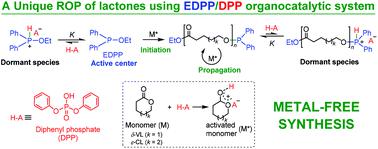当前位置:
X-MOL 学术
›
Polym. Chem.
›
论文详情
Our official English website, www.x-mol.net, welcomes your feedback! (Note: you will need to create a separate account there.)
Diphenyl phosphate/ethyl diphenylphosphinite as an efficient organocatalytic system for ring-opening polymerization of ε-caprolactone and δ-valerolactone
Polymer Chemistry ( IF 4.1 ) Pub Date : 2021-12-13 , DOI: 10.1039/d1py01289d Yanping Li 1 , Songyi Xu 2 , Jun Ling 2 , Ke Pan 1 , Yujian Liu 1 , Yougen Chen 1
Polymer Chemistry ( IF 4.1 ) Pub Date : 2021-12-13 , DOI: 10.1039/d1py01289d Yanping Li 1 , Songyi Xu 2 , Jun Ling 2 , Ke Pan 1 , Yujian Liu 1 , Yougen Chen 1
Affiliation

|
The present contribution reports a novel controlled/living ring-opening polymerization (ROP) method of ε-caprolactone (ε-CL) and δ-valerolactone (δ-VL) using ethyl diphenylphosphinite (EDPP) as an initiator and diphenyl phosphate (DPP) as a dual-role organocatalyst, which involves the activated monomer mechanism (AMM) and the reversible chain end deactivation process through a unique equilibrium reaction between the active phosphinite center and its protonated dormant species. To achieve controlled polymerization, the medium acidity of DPP is found to be significantly crucial because it not only promotes the monomer activation, but also helps in controlling the contents of the active and dormant species by establishing the above equilibrium reaction. In contrast, the use of either the much weaker benzoic acid or the much stronger triflimide cannot lead to a controlled ROP. The monomer-insertion reaction toward the P–O bond has been proven through polymer structure analyses using 1H NMR and MALDI-TOF MS spectra, from which the residual ethoxy group of EDPP is affirmed to bond at the initiating end of the polymer product. The unique ROP mechanism is verified based on the analyses of elementary reactions, polymerization kinetics, and polymer structures. The living nature of the current ROP is confirmed by polymerization kinetics and further by chain-extension experiments, which are employed to synthesize poly(ε-caprolactone)s (PCLs) and poly(δ-valerolactone)s (PVLs) with various controlled molar masses (PCL: 4300–41 900 g mol−1 and PVL: 2860–18 900 g mol−1) and moderate dispersities (Mw/Mn: 1.15–1.31), and also their block copolymers. Given the amount of an antioxidant agent (usually 0.05–0.5 wt%) practically used in commercial polymer products, these phosphinite end-functionalized polyesters are believed to have sufficient self-antioxidant properties.
中文翻译:

磷酸二苯酯/二苯基亚膦酸乙酯作为ε-己内酯和δ-戊内酯开环聚合的有效有机催化体系
本贡献报告了一种使用二苯基亚膦酸乙酯 (EDPP) 作为引发剂和磷酸二苯酯 (DPP) 的 ε-己内酯 (ε-CL) 和 δ-戊内酯 (δ-VL) 的新型受控/活性开环聚合 (ROP) 方法作为一种双重作用的有机催化剂,它涉及活化单体机制 (AMM) 和可逆链末端失活过程,通过活性次膦酸盐中心与其质子化休眠物质之间的独特平衡反应。为了实现受控聚合,发现 DPP 的中等酸度非常重要,因为它不仅可以促进单体活化,还有助于通过建立上述平衡反应来控制活性和休眠物种的含量。相比之下,使用弱得多的苯甲酸或强得多的三氟甲磺酰亚胺都不能实现受控的 ROP。已通过聚合物结构分析证明了单体插入 P-O 键的反应,使用1 H NMR 和 MALDI-TOF MS 光谱,从中证实 EDPP 的残留乙氧基键合在聚合物产物的起始端。基于对元素反应、聚合动力学和聚合物结构的分析,验证了独特的 ROP 机制。当前 ROP 的活性通过聚合动力学和链延长实验得到证实,这些实验用于合成具有各种受控摩尔数的聚(ε-己内酯)(PCL)和聚(δ-戊内酯)(PVL)质量(PCL:4300-41 900 g mol -1和 PVL:2860-18 900 g mol -1)和中等分散度( M w / M n: 1.15–1.31),以及它们的嵌段共聚物。考虑到商业聚合物产品中实际使用的抗氧化剂的量(通常为 0.05-0.5 wt%),这些亚膦酸酯末端官能化聚酯被认为具有足够的自抗氧化性能。
更新日期:2021-12-23
中文翻译:

磷酸二苯酯/二苯基亚膦酸乙酯作为ε-己内酯和δ-戊内酯开环聚合的有效有机催化体系
本贡献报告了一种使用二苯基亚膦酸乙酯 (EDPP) 作为引发剂和磷酸二苯酯 (DPP) 的 ε-己内酯 (ε-CL) 和 δ-戊内酯 (δ-VL) 的新型受控/活性开环聚合 (ROP) 方法作为一种双重作用的有机催化剂,它涉及活化单体机制 (AMM) 和可逆链末端失活过程,通过活性次膦酸盐中心与其质子化休眠物质之间的独特平衡反应。为了实现受控聚合,发现 DPP 的中等酸度非常重要,因为它不仅可以促进单体活化,还有助于通过建立上述平衡反应来控制活性和休眠物种的含量。相比之下,使用弱得多的苯甲酸或强得多的三氟甲磺酰亚胺都不能实现受控的 ROP。已通过聚合物结构分析证明了单体插入 P-O 键的反应,使用1 H NMR 和 MALDI-TOF MS 光谱,从中证实 EDPP 的残留乙氧基键合在聚合物产物的起始端。基于对元素反应、聚合动力学和聚合物结构的分析,验证了独特的 ROP 机制。当前 ROP 的活性通过聚合动力学和链延长实验得到证实,这些实验用于合成具有各种受控摩尔数的聚(ε-己内酯)(PCL)和聚(δ-戊内酯)(PVL)质量(PCL:4300-41 900 g mol -1和 PVL:2860-18 900 g mol -1)和中等分散度( M w / M n: 1.15–1.31),以及它们的嵌段共聚物。考虑到商业聚合物产品中实际使用的抗氧化剂的量(通常为 0.05-0.5 wt%),这些亚膦酸酯末端官能化聚酯被认为具有足够的自抗氧化性能。












































 京公网安备 11010802027423号
京公网安备 11010802027423号